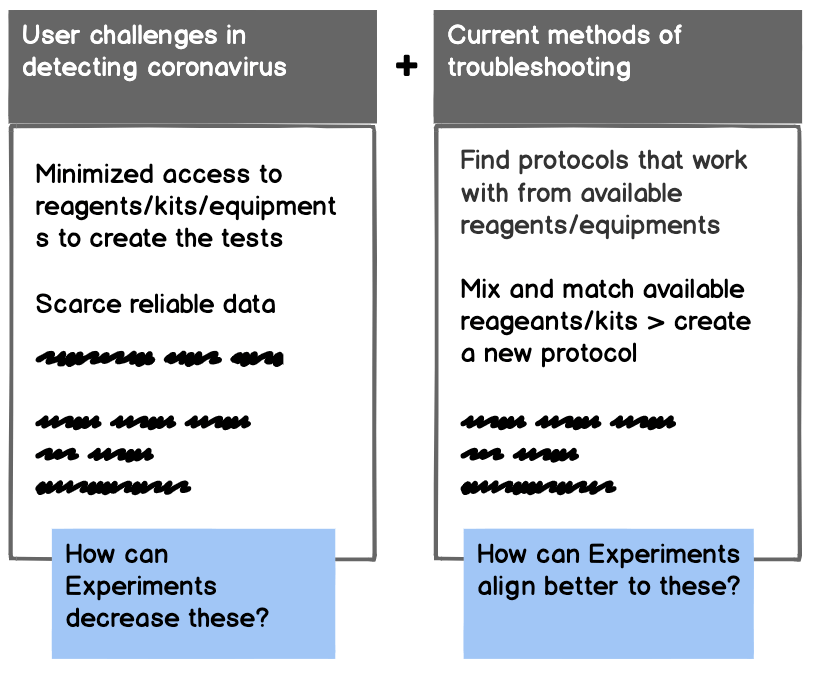Creating Solutions for COVID-19 Frontliners – a Case Study [Mind the Product]

 In Part 2 of our Coping Through COVID series, we learn how the team at Springer Nature Experiments quickly created an interface, packed with vital information on Coronavirus detection protocols for the scientific research community.
In Part 2 of our Coping Through COVID series, we learn how the team at Springer Nature Experiments quickly created an interface, packed with vital information on Coronavirus detection protocols for the scientific research community.
Overview
COVID-19 caused by the SARS-CoV-2 virus has brought everyday life to a halt all around the world. In mid-March, when COVID-19 reached 270,000+ cases globally, most of us started to work from home and to follow social distancing rules. Simultaneously, lockdown conditions and rising cases put immense pressure on healthcare personnel and researchers involved in the pandemic relief efforts.
As a UX designer and a product manager of a life-science research product, we resolved to deploy a digital solution that would provide researchers, working to develop COVID-19 tests, with easy access to much-needed information on coronavirus detection protocols.
In only 15 days, we were able to do just that. We identified over 160 well-established protocols from which we were able to present a quality, curated list to help users quickly find the information they needed.
Our Approach
At the point of the outbreak in January, there was very little information about the COVID-19 for researchers to use as they attempted to make detection tests. For those researchers, it was like having a brand new recipe to cook, without knowing most of the ingredients. The fallback option was to use information related to coronavirus.
As the world went into lockdown, the challenges for researchers became even bigger still. While researchers were able to go to their labs, supply was not easy to obtain. Due to lockdown, they could not easily access the reagents, kits and equipment they needed for testing. This, coupled with a lack of information about this new strain of the virus slowed the process, causing a testing backlog to build up.
Our first step, as a part of global response efforts, was to, therefore, identify all related coronavirus content already on Springer Nature Experiments and to make it openly accessible.
We then sought to identify detection protocols that would be helpful to different labs with access to different reagents. Our aim was to provide a curated list of protocols, saving them considerable time reviewing the wider literature.

Having defined the problem area, we conducted secondary research to ensure we understood our users’ needs and our current offering. We noticed that our users were following previously identified patterns of problem-solving and identified gaps between the user needs and our current product, which we translated into additional problem statements.

Collaborative Ideation
Next, we ran a virtual brainstorming workshop with our wider team. While they were aware of the core issues, they were not aware of the exact problems researchers were facing.
We, therefore, presented a 20-minute brief of the problem statements, before asking them to ideate. As ideas are assumptions that might add value to the user, we know we should not get attached to them and by asking the team to spend time coming up with ideas independently at first, we were able to prevent group bias.
With their initial ideas ready, they came together in two groups to collaborate, each group containing a mix of roles (UX, product, engineering).
Prioritization and Selection
With immediacy as a prerequisite, we prioritized these ideas based on user impact and dependencies.

Delivering the First Iteration
Next, we focused on sketching out the user journey, prototyping and gathering data. In five days, we identified all of the relevant, high-quality data of our database and developed the interface.

The Results
Our solution, Coronavirus Detection – Protocol Overviews, went live on 15 April 2020. Anyone can view it from our home page or by searching for coronavirus on Springer Nature Experiments.
Using an on-platform survey, we are currently collecting feedback to better understand user needs and requirements. We are also monitoring the situation and evolving user needs to improve our solution in meaningful ways. For example, as more content on coronavirus detection is published, it will be added to the Protocol Overviews.
So far (as of 24 April 2020), these survey results indicate that 84% of users find the new solution useful. Additional feedback has indicated that the new solution has made it easier for our users to find the information they need.
Conclusion
As a user-experience designer and product manager, our main learning from the process is that our individual roles, each with their unique expertise, critically complement each other. Our collaboration in the initial phase helped to bring fluidity to the process and make goal-setting an enriching dialogue between all product stakeholders.
Although active collaboration has led to many solutions previously, “Coronavirus Detection – Protocol Overviews” is special to us because of the urgent (pandemic) challenges, our learnings, and the fact that we deployed it in less than 15 days. As a team, we set a milestone for ourselves and are also proud to contribute to the global pandemic relief work.
Share Your Story
If you have a story or case study to share, we’d love to hear from you. Head here to complete our quick survey and, with the answers you provide, we will be able to create articles for those in the product community seeking professional insight, advice and inspiration.
The post Creating Solutions for COVID-19 Frontliners – a Case Study appeared first on Mind the Product.
Source: Mind the Product https://www.mindtheproduct.com/creating-solutions-for-covid-19-frontliners-a-case-study/

Post a Comment